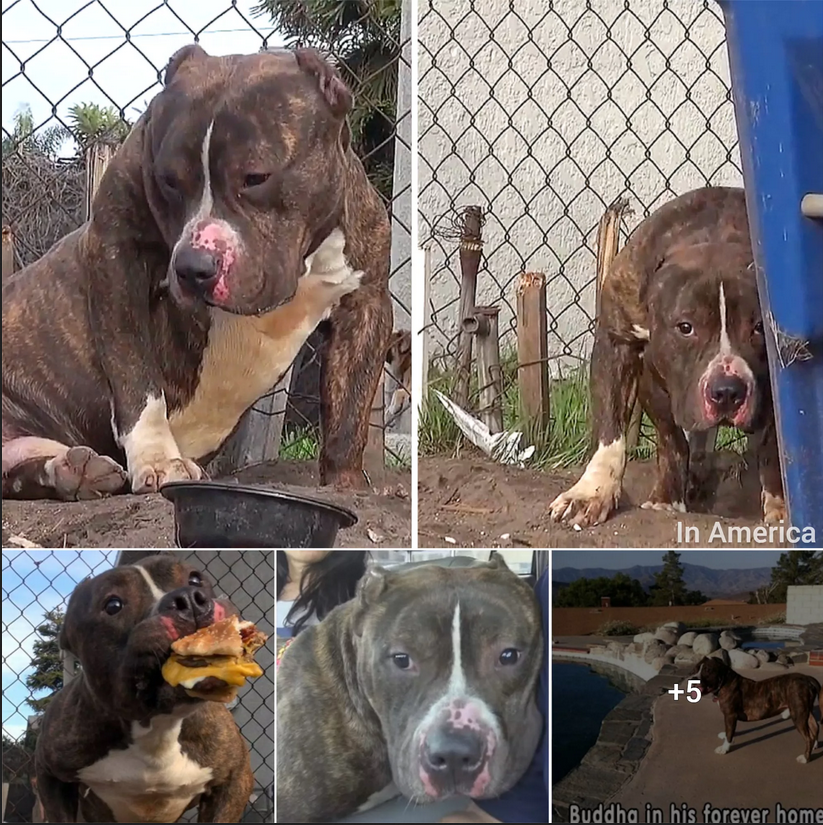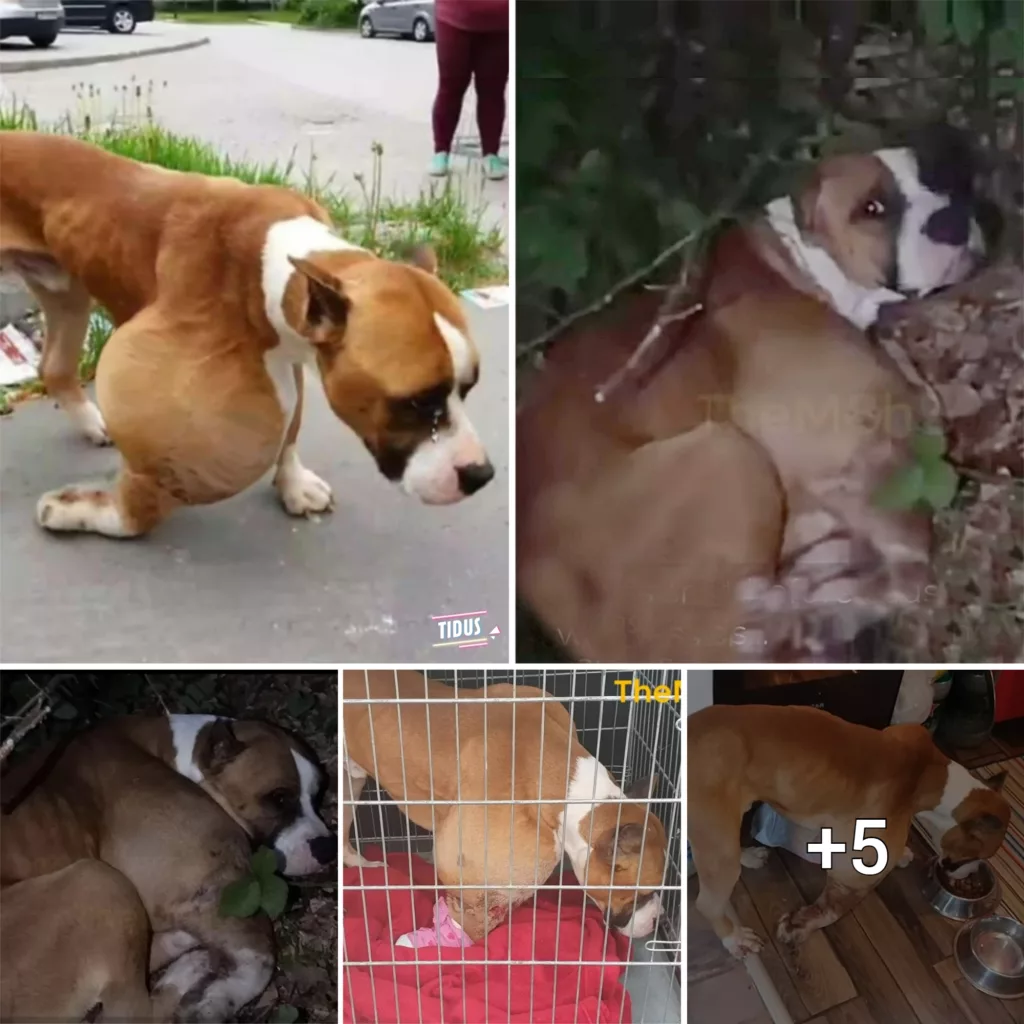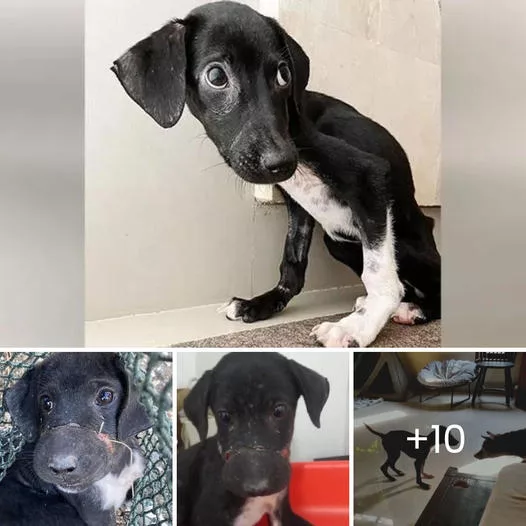The Poor Dog with Broken Spine and Jawbone Suffers Pain and Coldness, Desperately Seeking Help

It was a heartbreaking scene when we saw a dog dragging his body on the frozen ground, his spine and jawbone broken. He was obviously in excruciating pain, and the coldness seemed to add to his misery. We tried to approach him, but he was so scared and traumatized that he kept dragging himself away from us.
We called the animal rescue team, and they immediately came to the site. They managed to catch the dog and took him to the shelter. The veterinarian examined him and confirmed that he had a broken spine and jawbone. It was a severe injury that required surgery and long-term rehabilitation.

The poor dog was given pain relief medication and placed in a warm and comfortable bed. He was still frightened and confused, but he seemed to sense that he was in safe hands. We named him Lucky, hoping that he would overcome his ordeal and find a loving home.
The surgery was successful, but Lucky’s recovery was slow and challenging. He had to wear a brace to support his spine and was fed through a feeding tube as he could not chew his food. He underwent physical therapy to regain his mobility and strength.

Despite all the pain and hardship, Lucky remained a gentle and affectionate dog. He would wag his tail and lick our hands whenever we visited him at the shelter. His resilience and courage inspired us, and we knew that he deserved a second chance in life.
We launched a fundraising campaign to cover Lucky’s medical expenses and find him a forever home. The response was overwhelming, and we were able to raise enough money to pay for his treatment andaoption fees. Lucky was adopted by a loving family who adored him and gave him the care and attention he deserved.

Lucky’s story is a testimony to the resilience and compassion of animals and humans alike. No matter how broken and helpless we may feel, there is always hope and help available. We can make a difference in the lives of those who suffer and bring joy and love into the world.
Lucky’s journey from a broken and helpless dog to a beloved family pet is a testament to the power of compassion and perseverance. Let us all do our part to create a world where animals like Lucky can live a life free of pain and suffering.
Lucky’s story is not unique. There are countless animals out there who are suffering and desperately seeking help. Some have been abandoned or abused, while others are victims of accidents, diseases, or natural disasters. They may be injured, sick, malnourished, or traumatized, and they need immediate attention and care to survive and recover.

Animal rescue and rehabilitation organizations play a vital role in rescuing and rehabilitating animals like Lucky. These groups provide emergency assistance, medical treatment, and long-term support to animals in need. They work tirelessly to rescue, shelter, feed, and heal animals, and to find them safe and loving homes.
Animal rescue organizations operate in many different ways. Some have their own shelters or foster homes, while others partner with veterinary clinics, boarding facilities, or other organizations to provide temporary care. Many rely on donations, grants, and sponsorships to cover their expenses, while others have a revenue-generating business model, such as a thrift store or a pet food store.

Regardless of their size, structure, or funding model, animal rescue and rehabilitation organizations share a common goal: to alleviate animal suffering and promote animal welfare. They use a variety of methods and tools to achieve this, such as:
Rescue missions: These involve capturing and transporting animals in distress, often in hazardous or challenging conditions. Rescue teams may use specialized equipment, such as nets, traps, or boats, to reach animals in remote or inaccessible locations.
Medical treatment: This includes providing first aid, surgery, medication, and other veterinary care to animals with injuries, illnesses, or chronic conditions. Medical staff may work at a shelter, a clinic, or a mobile unit, and may collaborate with other healthcare professionals, such as physical therapists or nutritionists.

Rehabilitation and socialization: This focuses on helping animals recover from their trauma and regain their physical and mental abilities. Rehabilitation may include physical therapy, behavior modification, training, or socialization with other animals or humans.
Adoption and foster care: This involves finding permanent or temporary homes for animals that cannot be returned to the wild or their original owners. Adoption and foster care programs may involve screening potential adopters or foster parents, providing training and support, or organizing adoption events.

Education and outreach: This aims to raise awareness about animal welfare issues, promote responsible pet ownership, and encourage community involvement in animal rescue and rehabilitation. Education and outreach may include school visits, public events, social media campaigns, or newsletters.
Animal rescue and rehabilitation organizations face many challenges in their work. They may encounter resistance from local authorities, lack of funding, shortage of staff or volunteers, or legal obstacles. They may also face criticism or skepticism from the public, who may not understand or support their mission.

Despite these challenges, animal rescue and rehabilitation organizations continue to make a significant impact on the lives of animals and humans alike. They provide a vital service to the community, and they deserve our respect, admiration, and support.
You don’t have to be a professional animal rescuer or a wealthy donor to make a difference in the lives of animals. There are many ways you can help, regardless of your age, skills, or resources. Here are some ideas:

Adopt a rescue animal: By adopting a rescue animal, you are not only providing a loving home for a deserving animal, but also freeing up space and resources in a shelter or rescue organization. You can also foster an animal if you are not ready for a permanent commitment.
Donate to animal rescue organizations: You can donate money, supplies, or time to animal rescue and rehabilitation organizations. Check with your local shelter or rescue group to see what they need most.
Volunteer at a shelter or rescue organization: You can help care for animals, clean cages, walk dogs, or assist with adoption events. Contact your local shelter or rescue group to find out about volunteer opportunities.
Spread awareness: You can educate yourself and others about animal welfare issues, such as pet overpopulation, animal abuse, or responsible pet ownership. You can also share information on social medaor organize events to raise awareness.

Support animal-friendly policies: You can advocate for animal-friendly policies in your community, such as laws against animal cruelty, mandatory spay and neuter programs, or pet-friendly housing policies.
By taking action to support animal rescue and rehabilitation, we can ensure that animals like Lucky have a chance to live a life free of pain and suffering. Let’s make a difference, one animal at a time.
Lucky’s story is a reminder of the importance of animal rescue and rehabilitation. It is up to us to be the voice for animals in need and to support the organizations that work tirelessly to rescue, shelter, and heal them.
By adopting rescue animals, donating to animal welfare organizations, volunteering at shelters, or simply spreading awareness about animal cruelty and the importance of responsible pet ownership, we can all make a difference in the lives of animals.
Together, we can create a world where animals like Lucky can live a life free of pain and suffering, and where compassion and kindness prevail.



